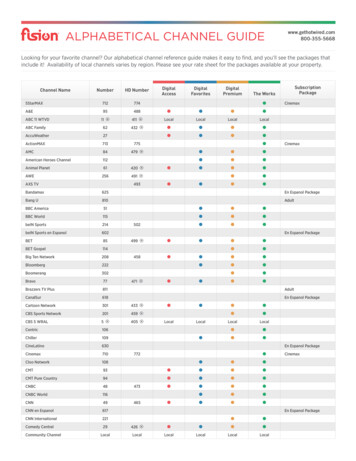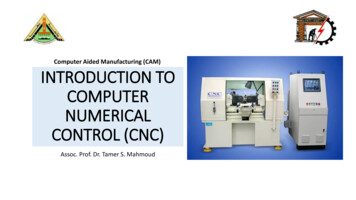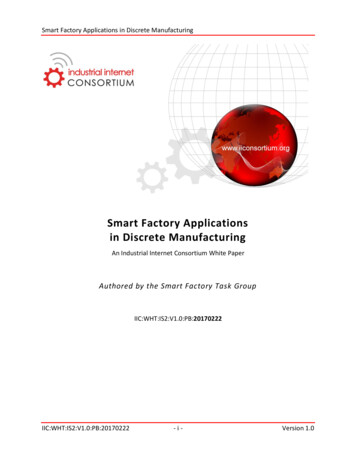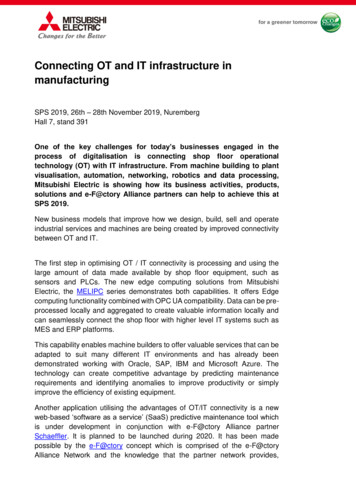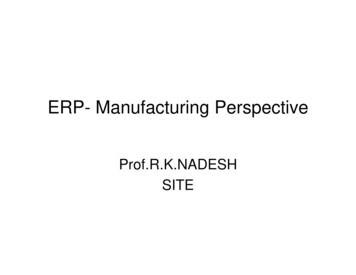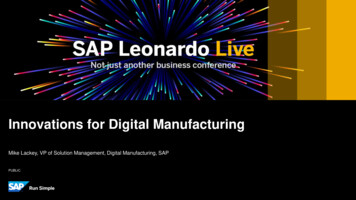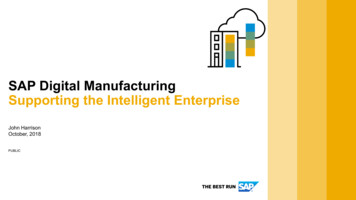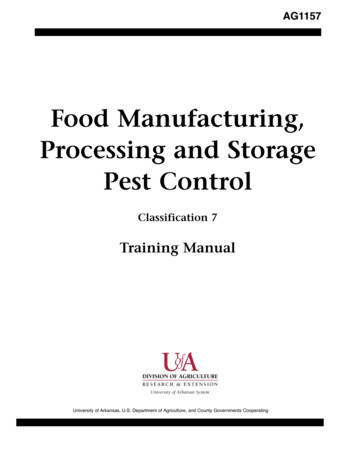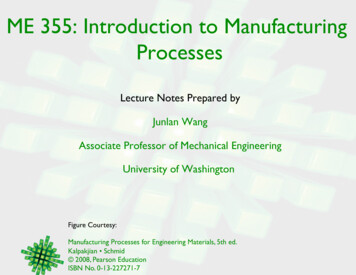
Transcription
ME 355: Introduction to ManufacturingProcessesLecture Notes Prepared byJunlan WangAssociate Professor of Mechanical EngineeringUniversity of WashingtonFigure Courtesy:Manufacturing Processes for Engineering Materials, 5th ed.Kalpakjian Schmid 2008, Pearson EducationISBN No. 0-13-227271-7
Chapter I Introduction
ManufacturingDesign and manufacturing - Concurrent EngineeringDesign for Manufacturing, Assembly, Disassembly, ServiceGreen Design, Sustainable Manufacturing, Product Life CycleMaterials Selection, Process SelectionComputer Integrated ManufacturingLean Production, Agile ManufacturingQuality Control, Total Quality AssuranceManufacturing Cost, Global Competitiveness
Definition and Importance ofManufacturingManufacturing: the process of converting raw materials into products; encompassethe deign and manufacturing of goods using various production methods andtechniques. came from Latin “manu factus” – made by handnterchangeably used with “production”“discrete” vs “continuous” productsManufactured item has monetary worth (added value) than raw materialsManufacturing is closely linked to national and global economy
Design and Manufacturingequential ProcessDesign - ManufacturingWaste resource, waste timeConcurrent ProcessAll disciplines are involved in theearliest stages of product designProgress concurrently so iterationsresults in less wasted effort and timeKey to success: well-recognizedcommunication among and withindisciplinesFIGURE 1.3(a) Chart showing various steps involved in demanufacturing a product. Depending on the complexity of the product a
Simultaneous EngineeringA systematic approach integrating the design and manufacture of theproducts with the view toward optimizing all elements involved in the lifecycle of the productBasic goal Minimize design and manufacture changesMinimize time and cost in taking the product from conceptual design to productionand introduction of the product to marketKey to success:–––Full support of an organization’s top managementMultifunctional and interacting work team, including support groupsUtilization of all available state-of-the-art technologies
Design for Manufacture, Assembly,Disassembly, and ServiceEach part or component of a product must be designed to not only meets desigrequirements and specifications, but also to be manufactured economically andrelative ease.Product must be designed that individual parts can be assembled together withspeed, and minimum cost.Product must also be designed so that disassembly is possible with relative easerequire little time, enabling the product to be taken apart for maintenance, servor recycling of their components.Product must be designed so that individual parts are easy to reach and service
Design Principle for Economic ProductionDesigns should be as simple as possible to manufacture, assembly, dissemble, serviand recycle.Materials should be chosen for their appropriate design and manufacturingcharacteristics as well as their service life.Dimensional accuracy and surface finish specified should be as broad as permissibleSecondary and finishing operations should be avoided or minimized to reduce cost
Life CycleGreen Design - Design for Recycling (DFR) - Design for Environmen(DFE)Sustainable Manufacturing––––Reducing waste of materials at their source by refinement in product designthe amount of materials usedReducing the use of hazardous materials in products and processesEnsuring proper handling and disposal of all wasteMaking improvements in waste treatment and recycling and reuse of materiaProduct Life Cycle (PLC)Product developmentMarket IntroductionGrowth, MaturationDecline––––
Materials used in today’s manufacturing––––––Ferrous metals: carbon steels, alloy steels, stainless steels, and tool and die steelsNonferrous metals and alloys: Al, Mg, Cu, Ni, superalloys, Ti, refractory metals (Mb, Nb, Wberyllium, Zr, low melting alloys (lead, zinc and tin), and precious metalsPlastics: Thermosets, thermoplastics, and elastomersCeramics: Glass ceramics, glasses, graphite, and diamondComposites: Reinforced plastics, metal-matrix and ceramics-matrix composites, and honeycstructuresNanomaterials, shape-memory alloys, metal foams, amorphous alloys, super conductors andsemiconductorsMaterial substitutionMaterial properties: mechanical, physical, chemical, manufacturingCost and availability
Categories of manufacturing processes––––––Casting: expandable molding and permanent moldingForming and shaping: rolling, forging, extrusion, drawing, sheet forming, powder metallurgymoldingMachining: turning, boring, drilling, milling, planing, shaping, broaching, grinding, ultrasonicmachining; chemical, electrical, and electrochemical machining and high energy electron beamachiningJoining: welding, brazing, soldering, diffusion bonding, adhesive bonding and mechanical joiniMicro and nano manufacturing: surface micromachining, dry and wet etching, and electroforFinishing: honing, lapping, polishing, burnishing, deburring, surface treating, coating and platinFactors affecting process selection Component/part shapeMaterials characteristics – castability, formability, machinability, weldability, etcPart size and dimensional accuracyManufacturing and operational cost
CIM applications––––––Control and optimization of manufacturing processMaterials handlingAssemblyAutomated inspection and testing of productsInventory controlManagementAdvantages––––Improved responsivenessBetter use of materials, machinery and personnel, reduction in inventoryBetter control of production and managementManufacturing high-quality at low-cost
Lean Production and Agile ManufacturingLean Production (also called lean manufacturing) –A major assessment of each activity of a company regarding the efficiency and effectiveness of itsoperationsThe efficiency of the machinery and equipment used in the operation while maintaining and improqualityThe number of personnel involved in a particular operationA thorough analysis in order to reduce the cost of each activity, including both productive andnonproductive laborGoal: continuously improving the efficiency and profitability by reducing all types of waste from its ope(0-base waste) and dealing with problems asap.Agile Manufacturing––Ensuring flexibility (agility) in the manufacturing enterprise so that it can quickly respond to changproduct variety and demand and customer needsTo be achieved through machines and equipment with built-in flexibility (reconfigurable machinesmodular components that can be arranged and rearranged in different ways, advance computer hardwsoftware, reduced chargeover time and implementing advanced communication systems.
ManagementProduct quality affects marketability and customer satisfactionQuality Assurance (QA) is now part of the concurrent engineering process andbuilt into every stage of the manufacturing processTotal Quality Management (TQM) and QA are the responsibility of everyoneinvolved in the design and manufacturing of a productStatistical Process Control is part of the TQM techniquesProduct liability
CompetitivenessManufacturing cost––– 40% of product selling priceIncludes cost of materials, tooling and labor, as well fixed and capital costsCan be minimized by optimizing design, least cost material, while maintaining the intended fuand characteristics, and materials substitution.Global competitiveness impacts manufacturing––––Markets become multinational and dynamicMarket condition fluctuates widelyDemand for high-quality, low-cost and timely deliveryIncreased product variety, complexity and shorter product life cycleWide disparity in manufacturing labor cost leads to outsourcingutsourcing – a practice of taking internal company activities and paying outside fito perform them.
Better MaterialsBetter control of composition, purity, and defects to enhance their overallproperties, manufacturing characteristics, reliability, and service life while keepincost lowBetter recyclability, and higher strength-, stiffness-to-weight ratio materials dueconcerns over energy and material savingBetter tool, die and mold materials with better resistance to process variable, thhigher efficiency and economics of manufacturing processesImproved efficiency and reliability of all manufacturing processes, equipment andsystems due to continuing development in computers, controls, industrial robotautomated inspection, handling and assembly, and sensor technology
ManufacturingConcurrent EngineeringDesign for Manufacturing, Assembly, Disassembly, ServiceGreen Design, Sustainable Manufacturing, Product Life CycleMaterials Selection, Process SelectionComputer Integrated ManufacturingLean Production, Agile ManufacturingQuality Control, Total Quality AssuranceManufacturing Cost, Global Competitiveness
and Global EconomyIn 1982, wealth is closely tied withlevel of manufacturing.Trend is no longer clear Abundant natural resources% contribution may not reflect theabsolute level of manufacturingGlobal trading leads to increased wealthin all participating countriesNations with higher GDP haveeconomic activity concentrated onhigh value-added produces, e.g,airplanes, automobiles, electronics.Labor intensive manufacturing isassociated with countries who followFIGURE 1.2 Importance of manufacturing toeconomies. The trends shown are from 1982 untSource: After J.A. Schey with data from theDevelopment Report, World Bank, various years.
Component/part shapeMaterials characteristics –castability, formability,machinability, weldability, etcPart size and dimensional accuracyManufacturing and operationalcost
ange of Materials & Processes in a TractoFIGURE 1.1 Model 8430 tractor, with detailed illusdiesel engine, showing the variety of materials anincorporated. Source: Courtesy of John Deere Compa
Range of Materials & Processes in a Tractor Manufacturing Processes for Engineering Materials, 5th ed. FIGURE 1.1 Model 8430 tractor, with detailed illustration of its diesel engine, showing the variety of materials and

